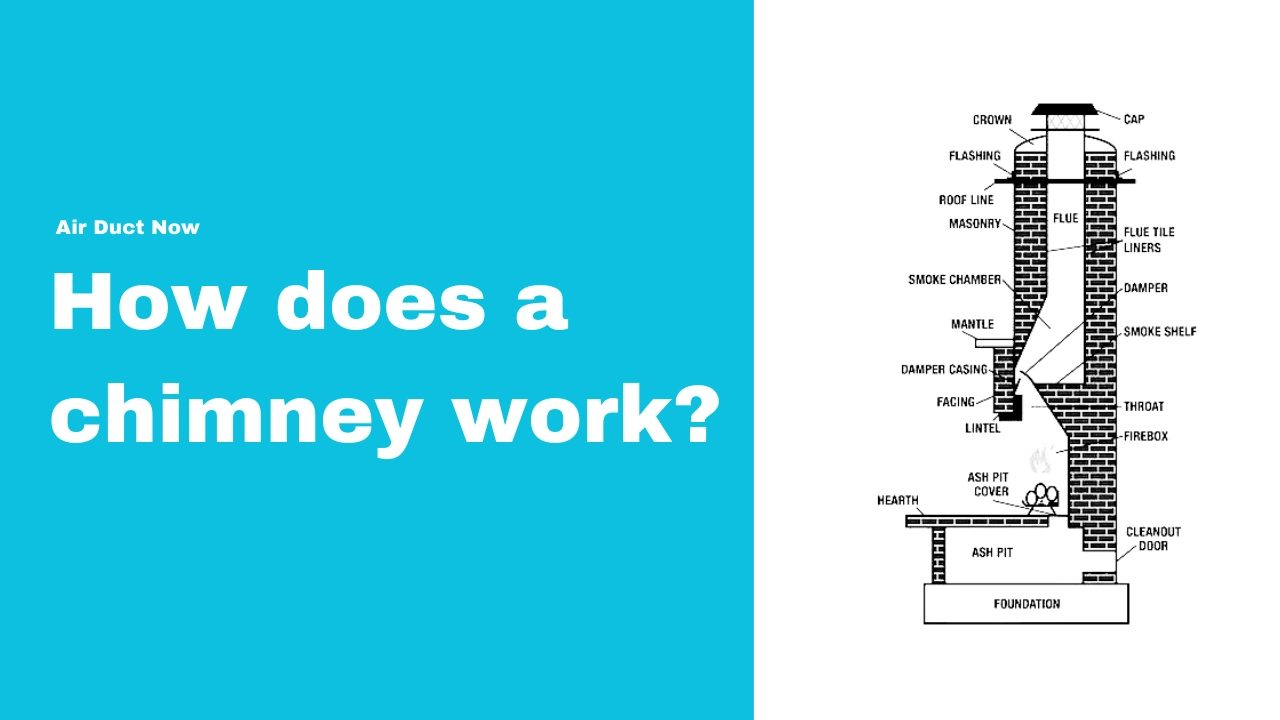A chimney is a vital thing of many homes and buildings, especially those with fireplaces or wood-burning stoves. Its primary function is to safely remove the byproducts of combustion, such as smoke, gases, and particles, from the interior of the building to the outdoors.
Chimneys work on the principle of buoyancy, also known as the stack effect. When a fire is burning in the fireplace or stove, hot air and gases rise up through the flue, creating a pressure difference between the inside and outside of the chimney. This pressure difference causes air from inside the building to be drawn up into the chimney, while fresh air is pulled in from outside to replace it. This constant flow of air helps to maintain proper ventilation and prevent the buildup of harmful gases inside the building.
The structure of a chimney plays a crucial role in its functioning. A typical chimney consists of several key components, including the firebox, smoke chamber, flue, and chimney cap. The firebox is where the fire is contained, while the smoke chamber helps to direct the flow of smoke and gases into the flue.
The flue is a passageway that runs vertically through the chimney, allowing for the escape of combustion byproducts. The chimney cap sits atop the flue, preventing debris, animals, and water from entering the chimney while still allowing for proper ventilation.
Why Understanding Your Chimney Matters
How your chimney works is important for several reasons. Firstly, a properly functioning chimney is crucial for the safety of your home and those inside it. If combustion byproducts are not being effectively removed from your home, they can pose a serious health hazard by causing respiratory issues and even carbon monoxide poisoning.
A well-maintained chimney can also help improve the efficiency of your fireplace or wood-burning stove. When the flow of air through the chimney is unobstructed, it allows for better combustion of fuel, resulting in a cleaner and more efficient burn. This not only reduces the amount of smoke and particles released into the air but also helps to minimize creosote buildup, which can lead to chimney fires.

Chimney Cap
A chimney cap is an essential part of a chimney system, as it serves to protect the chimney from a variety of potential hazards. The main purpose of a chimney cap is to prevent debris, animals, and water from entering the chimney while still allowing for proper ventilation. Here are some key reasons why a chimney cap is vital:
Without a chimney cap, leaves, twigs, branches, and other debris can easily fall into the chimney and block the flue. Birds, squirrels, raccoons, and other critters are known to make their homes in chimneys, especially during the colder months. A chimney cap acts as a barrier, preventing animals from entering the chimney and causing obstructions or damage.
Rainwater can enter the chimney and cause damage to the flue lining, masonry, and fireplace components. A chimney cap helps to divert water away from the chimney opening, keeping it dry and preventing costly water-related repairs.
A properly installed chimney cap allows for proper ventilation, ensuring that smoke and gases can escape efficiently while still keeping out unwanted elements. This helps to maintain good airflow through the chimney and prevents issues such as downdrafts or backdrafts.
Chimney Crown
The chimney crown is another important component of a chimney system that plays a key role in protecting the structure from water damage. Located at the very top of the chimney, the crown is a slab of concrete or mortar that covers and seals the top of the chimney stack. Here are some reasons why a chimney crown is important:
The main function of the chimney crown is to prevent water from entering the chimney structure. Without a properly constructed and maintained crown, water can seep into the masonry, leading to damage such as spalling (flaking or crumbling), cracks, and deterioration of the chimney’s interior components.
Water that enters the chimney can freeze and expand during cold weather, causing further damage to the masonry. The chimney crown helps to keep water out, protecting the chimney from the damaging effects of freeze-thaw cycles.
In addition to keeping water out, the chimney crown also helps to prevent debris such as leaves, twigs, and pests from entering the chimney and causing blockages or damage.
The chimney crown provides a stable base for the flue liner and helps to support the weight of the chimney structure above. A well-built chimney crown can help to prevent shifting or collapsing of the chimney stack, ensuring its stability and longevity.
Chimney Flue
The chimney flue is a vital component of the chimney system, facilitating the safe exit of smoke, gases, and combustion byproducts from a home.
The primary function of the chimney flue is to provide a pathway for smoke and gases to exit the home, ensuring that they do not build up inside and pose a health or safety hazard. Proper ventilation is essential for maintaining good air quality in the home and preventing the risk of carbon monoxide poisoning.
It helps to regulate the draft, or airflow, within the chimney. A well-designed flue ensures that smoke and gases are drawn up and out of the home efficiently, preventing issues such as downdrafts or backdrafts that can cause smoke to enter the home.
The chimney flue also provides insulation to help keep the flue gases hot as they rise through the chimney. This helps to ensure that the gases continue to rise and exit the home properly without cooling and creating a buildup of creosote, a highly flammable substance that can lead to chimney fires.
Chimney Damper
The chimney damper is a crucial part of a chimney system, regulating airflow and controlling heat escape through the chimney.
The chimney damper can be opened or closed to control the amount of air entering and exiting the chimney. This allows you to adjust the draft and ensure that the fire burns efficiently and safely, without wasting excess heat.
By controlling the airflow, the chimney damper helps to prevent warm air from escaping up the chimney when the fireplace is not in use. The chimney damper can also help to prevent downdraft s by creating a barrier that blocks cold air from entering the home through the chimney. This can help to maintain a comfortable indoor temperature and prevent drafts that can make your home feel colder.
Chimney Liner
The chimney liner is a crucial part of a chimney system, serving as a protective barrier to control and direct combustion by-products.
The chimney liner helps to protect the interior walls of the chimney from extreme heat and corrosive by-products of combustion. Without a liner, the intense heat from the fireplace or stove can transfer directly to the chimney walls, leading to potential damage or deterioration over time. The liner acts as a barrier, preventing direct contact between the hot gases and the chimney structure.
A properly sized and insulated chimney liner can improve the draft within the chimney, helping to ensure that the gases exit the home efficiently and safely. By providing a smooth and insulated passageway for the gases to travel through, the liner helps to minimize resistance and maintain a strong draft.
The chimney liner helps to reduce the risk of chimney fires by containing heat and preventing combustible materials from coming into contact with the chimney walls. It also helps to prevent carbon monoxide from entering the home by directing it up and out of the chimney.
Chimney Flashing
Chimney flashing is a crucial component of a chimney system that prevents water from entering a home through the intersection between the chimney and roof.
It is typically made of metal (such as aluminium or copper) and is installed around the base of the chimney where it meets the roof. This metal flashing creates a watertight seal that prevents rain, snow, and other forms of moisture from seeping into the home through the chimney structure. This helps to protect the interior of the chimney, as well as the surrounding roof and walls, from water damage.
Regular inspection and maintenances of chimney flashing are important to ensure that it remains intact and functional. Over tie, flashing can deteriorate due to exposure to the eluents, causing gaps or leaks that ay allow water to enter the hoe. If you notice any signs of damage or deterioration, it is important to have the flashing repaired or replaced promptly to prevent water damage.
The Fireplace
The fireplace is the focal point of the chimney system, where the fire is lit and the heat is generated.
Here are some key elements of a fireplace and how it works:
- The firebox is where the actual fire burns. It is typically made of fire-resistant materials such as brick or refractory panels to withstand high temperatures. The size and design of the firebox can impact the efficiency and heat output of the fireplace.
- The damper is a metal flap located at the top of the firebox that can be opened or closed to control the flow of air and smoke. When starting a fire, the damper should be fully open to allow for proper ventilation. Once the fire is burning steadily, partially closing the damper can help regulate the temperature and prevent excessive heat loss.
- The flue is the passageway that allows smoke and gases to escape from the fireplace and chimney. It is typically made of metal or clay tiles and runs vertically through the chimney structure. It must be clear of obstructions and properly sized to ensure proper draft for the fireplace.
Summary
A chimney works by creating a draft or airflow that allows smoke and gases from a fire to safely exit a building. The chimney is designed to be taller than the roofline to create a stack effect, where warm air rises and draws cooler air in through the fireplace or stove. This creates a continuous flow of air that carries smoke and gases up and out of the chimney. The shape and size of the chimney, as well as the temperature difference between the inside and outside air, all play a role in how effectively the chimney works.
Inside the chimney, there may be various components such as a damper to control airflow, a smoke shelf to prevent downdrafts, and a flue liner to protect the chimney walls from heat and corrosion. These components help ensure that the chimney functions properly and safely by directing smoke and gases up and out of the building.
A chimney works by creating a natural airflow that allows smoke and gases to safely exit a building. By understanding how chimneys work and properly maintaining them, homeowners can enjoy the benefits of a warm fire while ensuring their safety.


